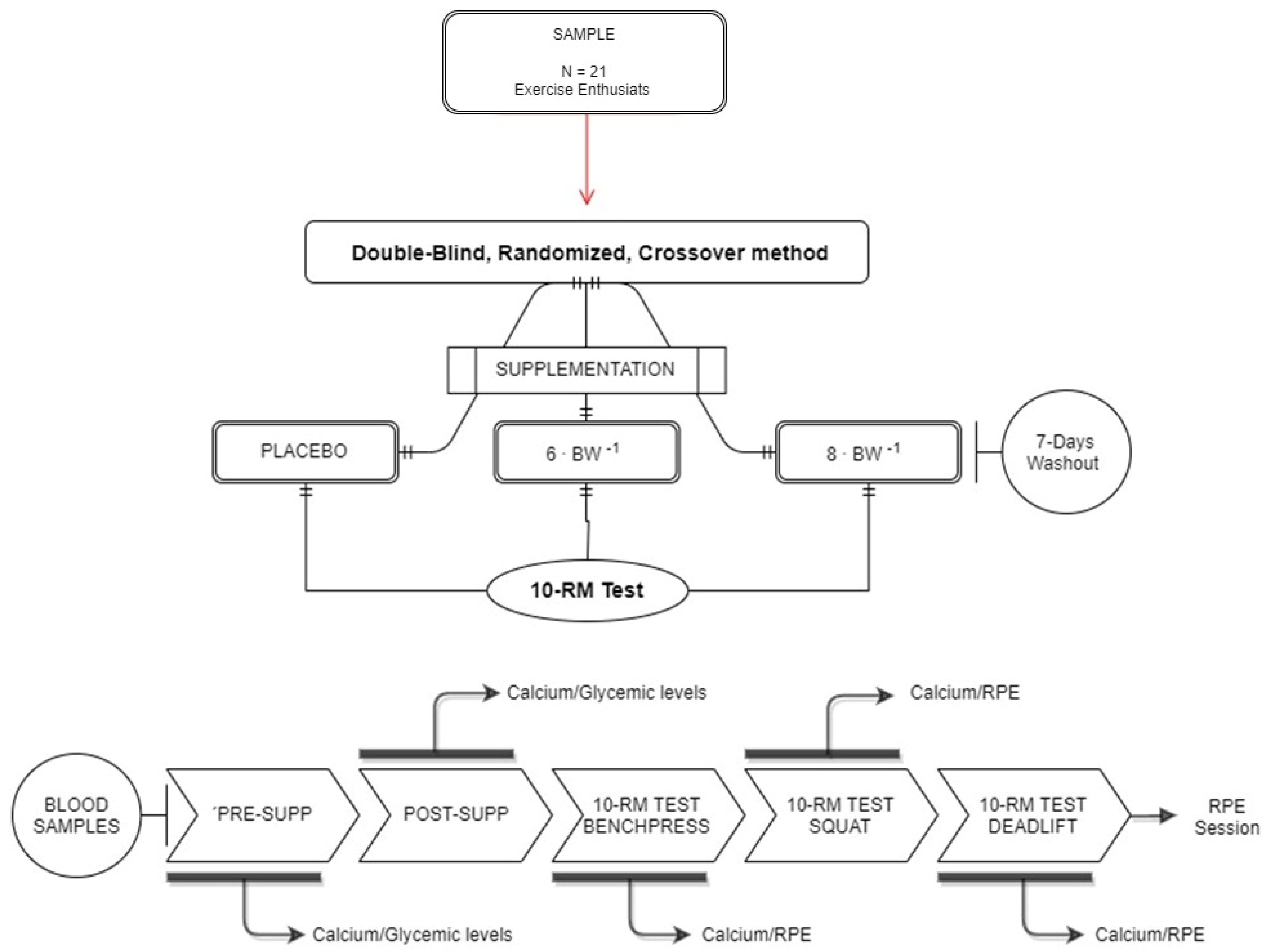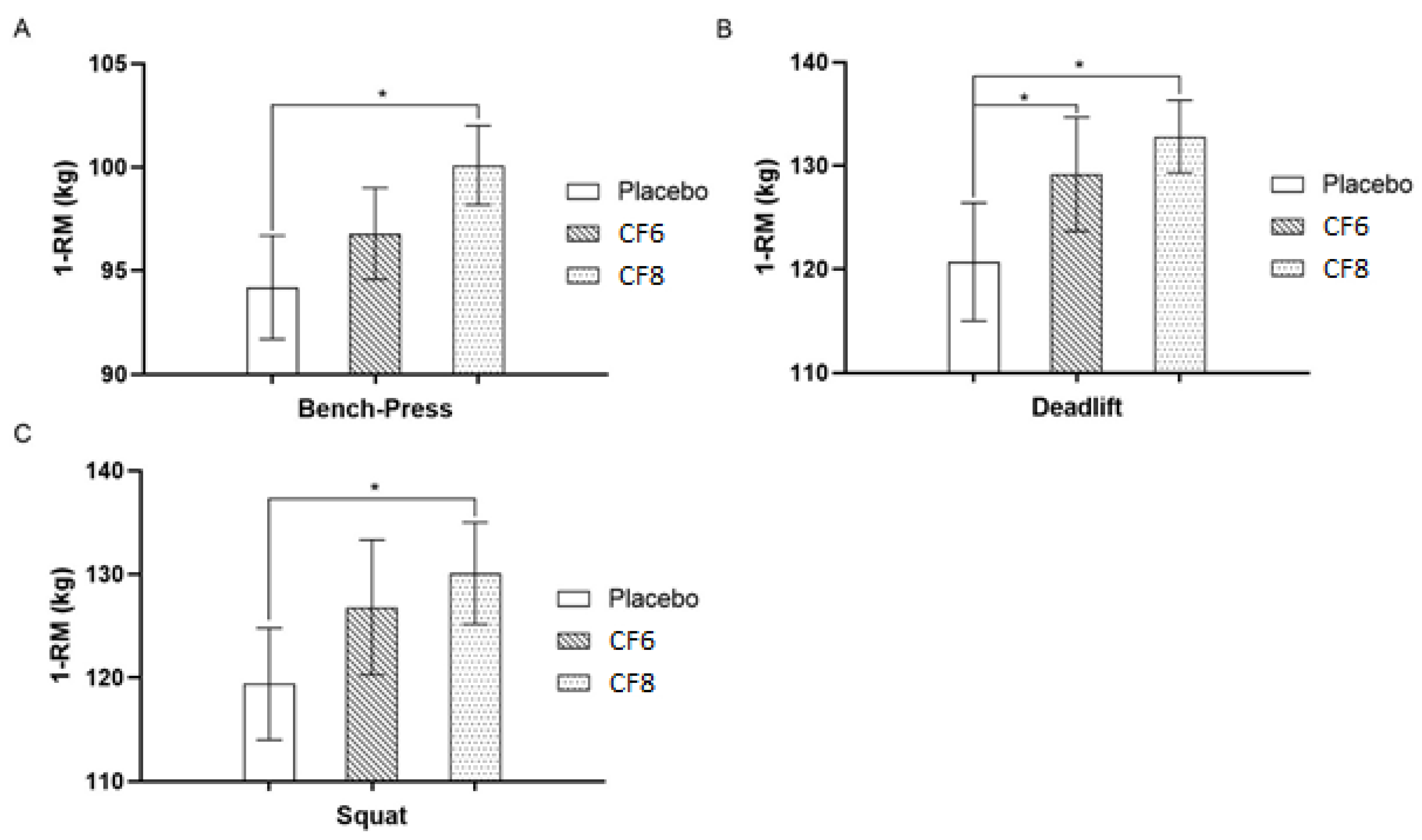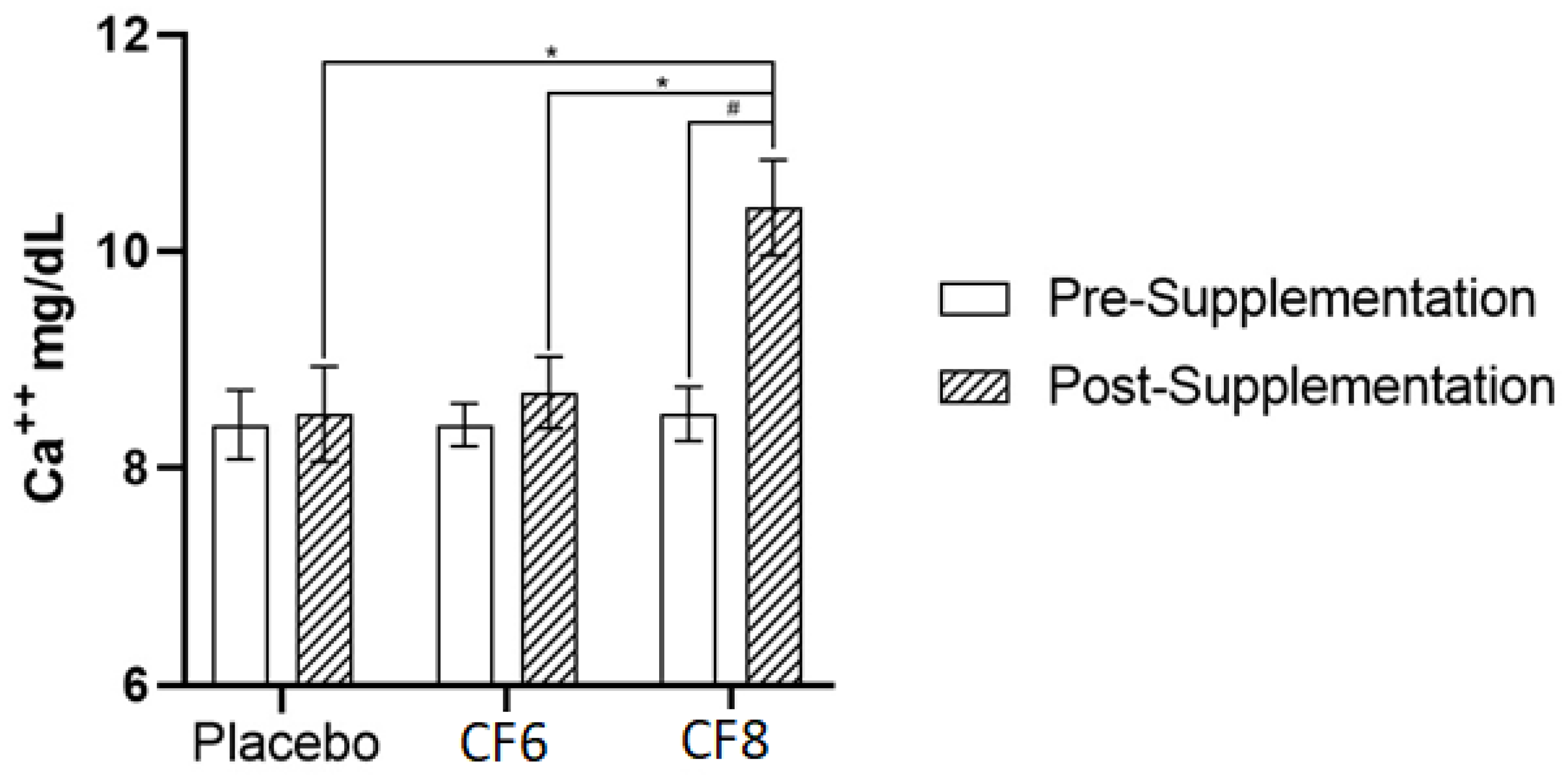High Doses of Caffeine Increase Muscle Strength and Calcium Release in the Plasma of Recreationally Trained Men
Highlights
- The study demonstrated that a higher dose of caffeine (8 mg per kg of body weight) significantly boosts muscle strength in recreationally trained men. This was evident in both upper and lower body exercises, with notable improvements in bench press, deadlift, and squat performances compared to lower doses and placebo.
- One of the standout findings was the increase in calcium release in the bloodstream following high-dose caffeine intake, which likely contributed to the enhanced muscle contractility and overall strength gains during the workouts.
- This research suggests that athletes or recreational lifters looking to improve strength performance might benefit from high-dose caffeine supplementation, offering a potentially valuable ergogenic aid during resistance training.
- With these findings, caffeine at 8 mg/kg body weight emerges as an effective strategy for those aiming to enhance muscle strength, making it a practical tool for optimizing resistance training outcomes.
Abstract
1. Introduction
2. Materials and Methods
2.1. Participants
2.2. Familiarization Trial and Repetition Maximum Assessment
2.3. Strength Test and 10-RM Protocol
2.4. Supplementation and Biochemical Analyzes Protocol
2.5. Statistical Analysis
3. Results
3.1. Strength Analysis
3.1.1. 1-RM on Bench Press
3.1.2. 1-RM on Deadlift
3.1.3. 1-RM on Squat
3.2. Calcium Release in Plasma
3.3. Rating of Perceived Exertion (RPE)
4. Discussion
5. Conclusions
Author Contributions
Funding
Institutional Review Board Statement
Informed Consent Statement
Data Availability Statement
Acknowledgments
Conflicts of Interest
References
- Schubert, M.M.; Hall, S.; Leveritt, M.; Grant, G.; Sabapathy, S.; Desbrow, B. Caffeine Consumption around an Exercise Bout: Effects on Energy Expenditure, Energy Intake, and Exercise Enjoyment. J. Appl. Physiol. 2014, 117, 745–754. [Google Scholar] [CrossRef] [PubMed]
- de Souza Junior, T.P.; Capitani, C.D.; Filho, I.L.; Viveiros, L.; Aoki, M.S. A Cafeína Potencializa O Desempenho Em Atividades De Endurance? Braz. J. Biomotricity 2012, 6, 144–152. [Google Scholar]
- McLellan, T.M.; Caldwell, J.A.; Lieberman, H.R. A Review of Caffeine’s Effects on Cognitive, Physical and Occupational Performance. Neurosci. Biobehav. Rev. 2016, 71, 294–312. [Google Scholar] [CrossRef] [PubMed]
- Graham, T.E.; Battram, D.S.; Dela, F.; El-Sohemy, A.; Thong, F.S.L. Does Caffeine Alter Muscle Carbohydrate and Fat Metabolism during Exercise? Appl. Physiol. Nutr. Metab. 2008, 33, 1311–1318. [Google Scholar] [CrossRef]
- Astorino, T.A.; Roberson, D.W. Efficacy of acute caffeine ingestion for short-term high-intensity exercise performance: A systematic review. J. Strength Cond. Res. 2010, 24, 257–265. [Google Scholar] [CrossRef]
- Klein, M.G.; Simon, B.J.; Schneider, M.F. Effects of caffeine on calcium release from the sarcoplasmic reticulum in frog skeletal muscle fibres. J. Physiol. 1990, 425, 599–626. [Google Scholar] [CrossRef]
- Allen, D.G.; Lamb, G.D.; Westerblad, H. Impaired Calcium Release during Fatigue. J. Appl. Physiol. 2008, 104, 296–305. [Google Scholar] [CrossRef]
- Meyers, B.M.; Cafarelli, E. Caffeine Increases Time to Fatigue by Maintaining Force and Not by Altering Firing Rates during Submaximal Isometric Contractions. J. Appl. Physiol. 2005, 99, 1056–1063. [Google Scholar] [CrossRef]
- Tarnopolsky, M.; Cupido, C. Caffeine Potentiates Low Frequency Skeletal Muscle Force in Habitual and Nonhabitual Caffeine Consumers. J. Appl. Physiol. 2000, 89, 1719–1724. [Google Scholar] [CrossRef]
- Daly, J.W. Caffeine Analogs: Biomedical Impact. Cell. Mol. Life Sci. 2007, 64, 2153–2169. [Google Scholar] [CrossRef]
- Sommerville, L.E.; Hartshorne, D.J. Intracellular Calcium and Smooth Muscle Contraction. Cell Calcium 1986, 7, 353–364. [Google Scholar] [CrossRef]
- Beck, T.; Housh, T.; Schimdt, R.; Housh, D.; Coburn, J.; Malek, M.; Taeccssmea, C.J. The Acute Effects of a Caffeine-Containing Supplement on Strength, Muscular Endurance, and Anaerobic Capabilities. J. Strength Cond. Res. 2006, 20, 506–510. [Google Scholar] [PubMed]
- Trexler, E.T.; Smith-Ryan, A.E.; Roelofs, E.J.; Hirsch, K.R.; Mock, M.G. Effects of Coffee and Caffeine Anhydrous on Strength and Sprint Performance. Eur. J. Sport Sci. 2016, 16, 702–710. [Google Scholar] [CrossRef] [PubMed]
- Astorino, T.A.; Terzi, M.N.; Roberson, D.W.; Burnett, T.R. Effect of Two Doses of Caffeine on Muscular Function during Isokinetic Exercise. Med. Sci. Sports Exerc. 2010, 42, 2205–2210. [Google Scholar] [CrossRef] [PubMed]
- Beaumont, R.E.; James, L.J. Effect of a Moderate Caffeine Dose on Endurance Cycle Performance and Thermoregulation during Prolonged Exercise in the Heat. J. Sci. Med. Sport 2017, 20, 1024–1028. [Google Scholar] [CrossRef] [PubMed]
- Trevino, M.A.; Coburn, J.W.; Brown, L.E.; Judelson, D.A.; Malek, M.H.; Attos, N.I. Acute effects of caffeine on strength and muscle activation of the elbow flexors. J. Strength Cond. Res. 2015, 29, 513–520. [Google Scholar] [CrossRef] [PubMed]
- Astorino, T.A.; Rohmann, R.L.; Firth, K. Effect of Caffeine Ingestion on One-Repetition Maximum Muscular Strength. Eur. J. Appl. Physiol. 2008, 102, 127–132. [Google Scholar] [CrossRef]
- Goldstein, E.; Jacobs, P.L.; Whitehurst, M.; Penhollow, T.; Antonio, J. Caffeine Enhances Upper Body Strength in Resistance-Trained Women. J. Int. Soc. Sports Nutr. 2010, 7, 18. [Google Scholar] [CrossRef]
- Grgic, J.; Grgic, I.; Pickering, C.; Schoenfeld, B.J.; Bishop, D.J.; Pedisic, Z. Wake up and Smell the Coffee: Caffeine Supplementation and Exercise Performance—An Umbrella Review of 21 Published Meta-Analyses. Br. J. Sports Med. 2020, 54, 681–688. [Google Scholar] [CrossRef]
- Aroom, K.R.; Harting, M.T.; Cox, C.S.; Radharkrishnan, R.S.; Smith, C.; Gill, B.S. Bioimpedance Analysis: A Guide to Simple Design and Implementation. J. Surg. Res. 2009, 153, 23–30. [Google Scholar] [CrossRef]
- Robertson, R.J.; Goss, F.L.; Rutkowski, J.; Lenz, B.; Dixon, C.; Timmer, J.; Frazee, K.; Dube, J.; Andreacci, J. Concurrent Validation of the OMNI Perceived Exertion Scale for Resistance Exercise. Med. Sci. Sports Exerc. 2003, 35, 333–341. [Google Scholar] [CrossRef] [PubMed]
- Heckman, M.A.; Weil, J.; de Mejia, E.G. Caffeine (1, 3, 7-Trimethylxanthine) in Foods: A Comprehensive Review on Consumption, Functionality, Safety, and Regulatory Matters. J. Food Sci. 2010, 75, 77–87. [Google Scholar] [CrossRef] [PubMed]
- Rhea, R.M. Determining the magnitude of treatment effects in strength training research through the use of the effect size. J. Strength Cond. Res. 2004, 18, 918–920. [Google Scholar] [PubMed]
- Clarke, D.N.; Kornilios, E.; Richardson, L.D. Carbohydrate and caffeine mouth rinses do not affect maximum strength and muscular endurance performance. J. Strength Cond. Res. 2015, 29, 2926–2931. [Google Scholar] [CrossRef]
- Ali, A.; O’Donnell, J.; Foskett, A.; Rutherfurd-Markwick, K. The Influence of Caffeine Ingestion on Strength and Power Performance in Female Team-Sport Players. J. Int. Soc. Sports Nutr. 2016, 13, 46. [Google Scholar] [CrossRef]
- Behrens, M.; Mau-Moeller, A.; Weippert, M.; Fuhrmann, J.; Wegner, K.; Skripitz, R.; Bader, R.; Bruhn, S. Caffeine-Induced Increase in Voluntary Activation and Strength of the Quadriceps Muscle during Isometric, Concentric and Eccentric Contractions. Sci. Rep. 2015, 5, 10209. [Google Scholar] [CrossRef]
- Timmins, D.T.; Saunders, H.D. Effect of Caffeine Ingestion on Maximal Voluntary Contraction Strength in Upper- and Lower-Body Muscle Groups. J. Strength Cond. Res. 2014, 28, 3239–3244. [Google Scholar] [CrossRef]
- Wilk, M.; Krzysztofik, M.; Filip, A.; Zajac, A.; Del Coso, J. The Effects of High Doses of Caffeine on Maximal Strength and Muscular Endurance in Athletes Habituated to Caffeine. Nutrients 2019, 11, 1912. [Google Scholar] [CrossRef]
- Paula, A.; Melo, F.; Salles, R.K.; De Gracieli, F.; Vieira, K. RBCDH Methods for Estimating Body Weight and Height in Hospitalized Adults: A comparative analysis. Rev. Bras. De Cineantropometria Desempenho Hum. 2014, 16, 475–484. [Google Scholar]
- Grgic, J.; Mikulic, P.; Schoenfeld, B.J.; Bishop, D.J.; Pedisic, Z. The Influence of Caffeine Supplementation on Resistance Exercise: A Review. Sport. Med. 2019, 49, 17–30. [Google Scholar] [CrossRef]
- Maughan, R.J.; Burke, L.M.; Dvorak, J.; Larson-Meyer, D.E.; Peeling, P.; Phillips, S.M.; Rawson, E.S.; Walsh, N.P.; Garthe, I.; Geyer, H.; et al. IOC Consensus Statement: Dietary Supplements and the High-Performance Athlete. Br. J. Sports Med. 2018, 52, 439–455. [Google Scholar] [CrossRef] [PubMed]
- Martins, G.; Guilherme, J.P.L.; Boiko Ferreira, L.; Souza-Junior, T.; Lancha, A., Jr. Caffeine and Exercise Performance: Possible Directions for Definitive Findings. Front. Sport. Act. Living 2021, 117, 574854. [Google Scholar] [CrossRef] [PubMed]
- Davis, J.K.; Green, J.M. Caffeine and Anaerobic Performance. Sport. Med. 2009, 39, 813–832. [Google Scholar] [CrossRef] [PubMed]
- Grgic, J.; Pickering, C. The Effects of Caffeine Ingestion on Isokinetic Muscular Strength: A Meta-Analysis. J. Sci. Med. Sport 2019, 22, 353–360. [Google Scholar] [CrossRef] [PubMed]
- Bell, D.G.; McLellan, T.M. Exercise Endurance 1, 3, and 6 h after Caffeine Ingestion in Caffeine Users and Nonusers. J. Appl. Physiol. 2002, 93, 1227–1234. [Google Scholar] [CrossRef] [PubMed]
- Lara, B.; Ruiz-Moreno, C.; Salinero, J.J.; Del Coso, J. Time Course of Tolerance to the Performance Benefits of Caffeine. PLoS ONE 2019, 14, e0210275. [Google Scholar] [CrossRef] [PubMed]
- Tarnopolsky, M.A. Caffeine and Creatine Use in Sport. Ann. Nutr. Metab. 2011, 57, 1–8. [Google Scholar] [CrossRef]
- Gomes-Santos, J.A.F.; Lambertucci, R.H.; Vardaris, C.V.; Passos, M.E.P.; Silva-Junior, E.P.; Hatanaka, E.; Gorjão, R.; McAnulty, S.R.; Souza-Junior, T.P.; de Barros, M.P. Early Signs of Inflammation with Mild Oxidative Stress in Mixed Martial Arts Athletes after Simulated Combat. J. Strength Cond. Res. 2022, 36, 180–186. [Google Scholar] [CrossRef]
- Souza-Junior, T.P.; Lorenço-Lima, L.; Ganini, D.; Vardaris, C.V.; Polotow, T.G.; Barros, M.P. Delayed Uric Acid Accumulation in Plasma Provides Additional Anti-Oxidant Protection against Iron-Triggered Oxidative Stress after a Wingate Test. Biol. Sport 2014, 31, 271–276. [Google Scholar] [CrossRef]
- Jiang, H.; Stephens, N.L. Calcium and Smooth Muscle Contraction. Mol. Cell. Biochem. 1994, 135, 1–9. [Google Scholar] [CrossRef]
- Usachev, Y.; Shmigol, A.; Pronchuk, N.; Kostyuk, P.; Verkhratsky, A. Caffeine-Induced Calcium Release from Internal Stores in Cultured Rat Sensory Neurons. Neuroscience 1993, 57, 845–859. [Google Scholar] [CrossRef]
- Davis, J.M.; Zhao, Z.; Stock, H.S.; Mehl, K.A.; Buggy, J.; Hand, G.A. Central Nervous System Effects of Caffeine and Adenosine on Fatigue. Am. J. Physiol. -Regul. Integr. Comp. Physiol. 2003, 284, 399–404. [Google Scholar] [CrossRef] [PubMed]
- Berchtold, M.W.; Brinkmeier, H.; Müntener, M. Calcium Ion in Skeletal Muscle: Its Crucial Role for Muscle Function, Plasticity, and Disease. Physiol. Rev. 2000, 80, 1215–1265. [Google Scholar] [CrossRef] [PubMed]





| 1-Day Before Day 1 | 1-Day Before Day 2 | 1-Day Before Day 3 | |
|---|---|---|---|
| kcal | 2587 ± 430 | 2375 ± 441 | 2690 ± 355 |
| Carbohydrates (kcal) | 1241 ± 208 | 1235 ± 229 | 1479 ± 195 |
| Protein (kcal) | 905 ± 151 | 902 ± 167 | 807 ± 106 |
| Fats (kcal) | 439 ± 71 | 238 ± 45 | 404 ± 54 |
Publisher’s Note: MDPI stays neutral with regard to jurisdictional claims in published maps and institutional affiliations. |
© 2022 by the authors. Licensee MDPI, Basel, Switzerland. This article is an open access article distributed under the terms and conditions of the Creative Commons Attribution (CC BY) license (https://creativecommons.org/licenses/by/4.0/).
Share and Cite
Ferreira, L.H.B.; Forbes, S.C.; Barros, M.P.; Smolarek, A.C.; Enes, A.; Lancha-Junior, A.H.; Martins, G.L.; Souza-Junior, T.P. High Doses of Caffeine Increase Muscle Strength and Calcium Release in the Plasma of Recreationally Trained Men. Nutrients 2022, 14, 4921. https://doi.org/10.3390/nu14224921
Ferreira LHB, Forbes SC, Barros MP, Smolarek AC, Enes A, Lancha-Junior AH, Martins GL, Souza-Junior TP. High Doses of Caffeine Increase Muscle Strength and Calcium Release in the Plasma of Recreationally Trained Men. Nutrients. 2022; 14(22):4921. https://doi.org/10.3390/nu14224921
Chicago/Turabian StyleFerreira, Luis H. B., Scott C. Forbes, Marcelo P. Barros, André C. Smolarek, Alysson Enes, Antonio H. Lancha-Junior, Gabriel L. Martins, and Tacito P. Souza-Junior. 2022. "High Doses of Caffeine Increase Muscle Strength and Calcium Release in the Plasma of Recreationally Trained Men" Nutrients 14, no. 22: 4921. https://doi.org/10.3390/nu14224921
APA StyleFerreira, L. H. B., Forbes, S. C., Barros, M. P., Smolarek, A. C., Enes, A., Lancha-Junior, A. H., Martins, G. L., & Souza-Junior, T. P. (2022). High Doses of Caffeine Increase Muscle Strength and Calcium Release in the Plasma of Recreationally Trained Men. Nutrients, 14(22), 4921. https://doi.org/10.3390/nu14224921








